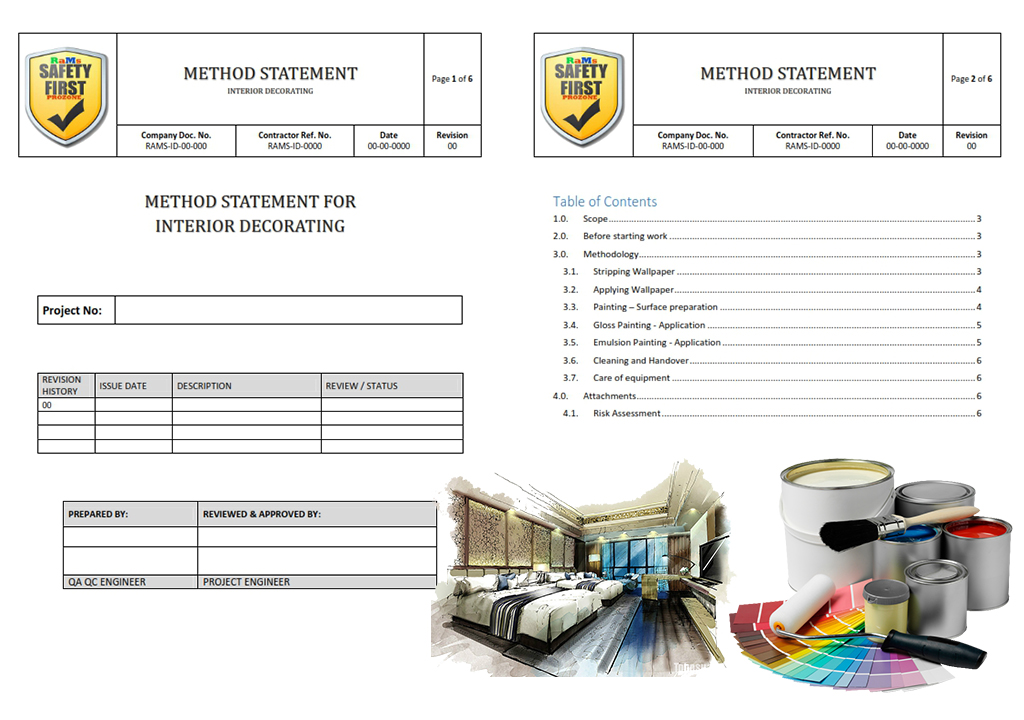
METHOD STATEMENT FOR INTERIOR DECORATING
The Method Statement for Interior Decorating by RaMsProZone outlines a systematic approach to transforming interior spaces. It details planning, material selection, surface preparation, and execution of decorative elements, ensuring quality and efficiency. Emphasis is placed on client collaboration, adherence to design specifications, and compliance with safety standards. The process includes color schemes, furniture placement, lighting, and finishing touches to create aesthetically pleasing and functional interiors, tailored to client preferences and project requirements.
Table of Contents
1.0. Scope
2.0. Before starting work
3.0. Methodology
3.1. Stripping Wallpaper
3.2. Applying Wallpaper
3.3. Painting – Surface preparation
3.4. Gloss Painting - Application
3.5. Emulsion Painting - Application
3.6. Cleaning and Handover
3.7. Care of equipment
4.0. Attachments
4.1. Risk Assessment
1.0. Scope
This method statement describes the work process for the re-decorating of the Commercial.
Premises at various Commercial Premises properties including:
A. Site establishment
B. Tenants warning and safety
C. Stripping and preparation
D. Wallpapering
E. Painting
F. Finishing
2.0. Before starting work
Inform the tenant and other occupants of work commencing and cordon off the work area if practical to do so. Particular attention should be paid to the property where Client Staff is present; All Client Personnel must be kept away from the work area at all times and protected from substances such as paint and paint strippers.
a. Ensure Personal Protective Equipment is worn at all times.
b. Place Warning signs at the extremes of the work area before the work commences.
c. Physically check the condition of all equipment before and after use
3.0. Methodology
3.1. Stripping Wallpaper
3.1.1. Put on your protective equipment
3.1.2. Ensure the area is stripped and exit points are clear of obstruction and that safe access and egress are maintained.
3.1.3. Carefully wet down wallpaper with warm soapy water and allow it to soak through
3.1.4. Remove existing wall finishes using scrapers.
3.1.5. Clean down walls using a proprietary cleaner
3.1.6. Remove all debris and waste to the designated waste disposal area
3.1.7. Do not leave tools and equipment unattended at any time.
3.1.8. Ensure the area is left safe at the end of each shift
3.1.9. Ensure cooking and bathroom facilities are operational at the end of each shift
3.2. Applying Wallpaper
3.2.1. Put on your protective equipment
3.2.2. Set up equipment required for the application of wallpaper
3.2.3. Mix sufficient paste for the area to be covered, refer to the Safety Sheet for paper paste
3.2.4. Cut the required lengths of paper and apply the paste
3.2.5. Hang and finish the paper as per contract instructions
3.2.6. When working from stepladders the company working at height procedure must be followed.
3.2.7. DO NOT REMOVE any light switches or sockets, cut and shape the paper around switches and sockets.
3.2.8. Remove all waste and debris from the site to the designated area, the site will be left clean and tidy at the end of each shift
3.3. Painting – Surface preparation
3.3.1. Put on your protective equipment
3.3.2. Cover the floor area and any furniture to prevent damage
3.3.3. Prepare surfaces to be painted by sanding/stripping and cleaning
3.3.4. If using chemical stripping agents such as Nitromors, you must read and understand the safety data sheet for the product you are using
3.3.5. Electric hot air stripping tools will be PAT tested on an annual basis and checked for defects daily, damaged or defective tools will be removed from service immediately
3.3.6. Electric hot air strippers can get extremely hot and therefore create a fire risk, ensure a suitable fire extinguisher is at hand during hot work.
3.3.7. N.B. Chemical cleaners and work tools, including hot air strippers, must not be left unattended in residential properties. This precaution is particularly crucial in homes where children are present.
3.3.8. Make sure any extension leads are kept tidy and do not cause a trip hazard
3.4. Gloss Painting - Application
3.4.1. Put on your protective equipment
3.4.2. Cover the floor area and any furniture etc with dust sheets to prevent paint splashes
3.4.3. Ensure suitable ventilation when using oil-based paints
3.4.4. When working from stepladders the company working at height procedure must be followed.
3.4.5. Smoking is not allowed in client properties
3.4.6. Ensure the surface is clean, dry, and free from dirt, grease, and oil
3.4.7. Do not leave paints open and unattended at any time
3.4.8. Apply undercoat and allow to dry, do not apply too much, and watch for runs, etc.
3.4.9. Check the undercoat for correct adhesion to the surface and wipe down if necessary
3.4.10. Apply gloss finish coat and allow to dry
3.5. Emulsion Painting - Application
3.5.1. Put on your protective equipment
3.5.2. Cover the floor area and any furniture etc with dust sheets to prevent paint splashes
3.5.3. Clean down the surface to be painted using the proprietary cleaner as per the instructions above
3.5.4. Ensure the surface is clean, dry, and free from dirt, grease, and oil
3.5.5. When working from stepladders the company working at height procedure must be followed.
3.5.6. Prepare paint for application. i.e. mixing etc
3.5.7. Apply emulsion paint with a brush or roller and allow it to dry, do not apply too much and watch for runs, etc
3.5.8. Check the first coat for correct coverage
3.5.9. Apply a second coat where necessary and allow to dry
3.6. Cleaning and Handover
3.6.1. The kitchen and Washrooms will be cleaned before handover; all waste and debris will be removed to the designated waste area.
3.6.2. The site manager will check all work before handover
3.6.3. Handover to client
3.7. Care of equipment
3.7.1. All items must be thoroughly cleaned in either water or the relevant solvent at the end of each shift
3.7.2. Items such as brushes and rollers should be air-dried and stored
3.7.3. Wash buckets, wipe inside and out, and store upside down
3.7.4. All items should be stored out of reach of tenants and children
4.0. Attachments
4.1. Risk Assessment




0 Comments